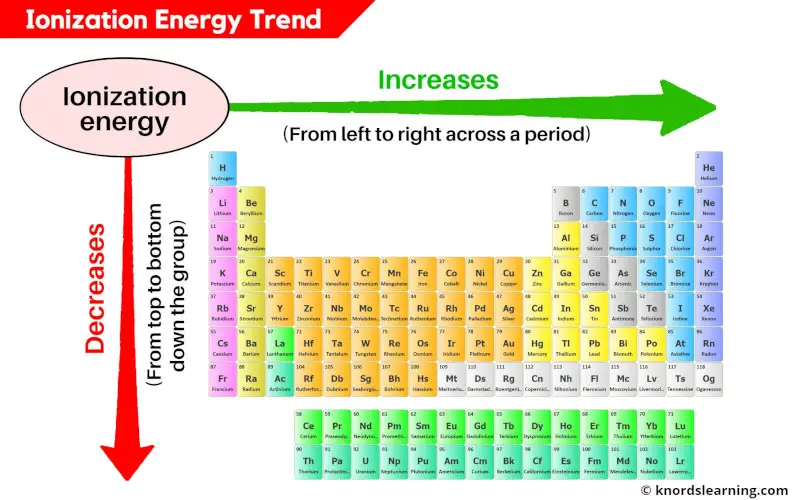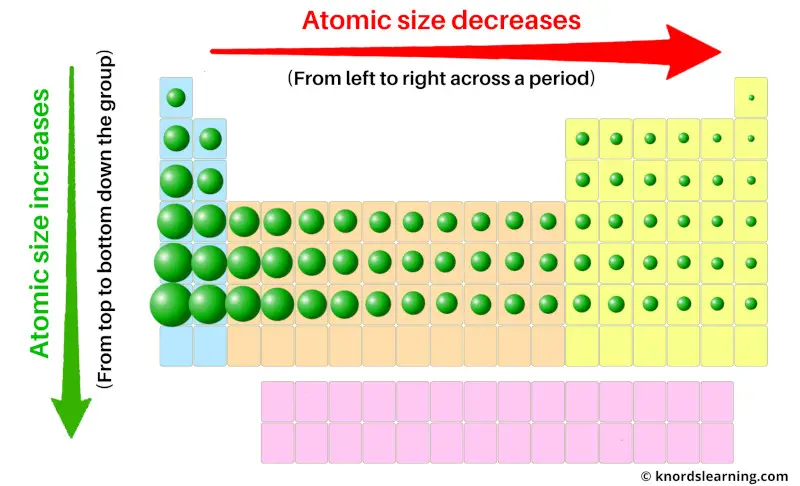
Ionization Energy Trend:
Across the period (from left to right): Increases
Down the group (from top to bottom): Decreases
The ionization energy of elements increases as we move across a period (from left to right) and it decreases as we move down in a group (from top to bottom).
Well this was just an introduction about the ionization energy trends in periodic table.
But you need to understand why the ionization energy trend of elements increases across a period and why it decreases down the group.
So let’s dive right into it!
Explanation about Ionization Energy Trend
In order to understand the ionization energy trend, you will first need to know about ionization energy.
So what is ionization energy?
Definition: Ionization energy is the minimum energy required to remove an electron from the gaseous atom or ion.

Let me explain this in simple words.
The electron cannot escape on its own. It requires some external energy in order to escape out of the orbit. This required energy is known as ionization energy.
Ionization energy also indicates the difficulty of removing an electron from an atom.
That means if it is more difficult to remove the electron, then it has more ionization energy.
One more concept:
You know that the nucleus of an atom contains protons which are positively charged particles. So these positively charged particles have a tendency to attract the negatively charged electrons which are around the nucleus.
Now you might be knowing the atomic size trend in periodic table.

If we move across the period (from left to right), then the atomic size decreases. And if we move down the group (from top to bottom), then the atomic size increases.
Now, what does a smaller atomic size indicate? And what does a larger atomic size indicate?
The smaller atomic size indicates that it has more attractive force for the electrons (because for smaller atom, the electrons are near to the nucleus).
So because of more attractive force, it becomes difficult to remove the electron from the orbit.
So finally we can say that, less the size of an atom, more is the ionization energy (energy required to remove the electron).
And larger the size of atom, less will be the ionization energy.
In simple words, ionization energy is inversely proportional to the atomic size.

As we move across the period (from left to right), the atomic size decreases, so the ionization energy increases.
And similarly as we move down the group (from top to bottom), the atomic size increases, so the ionization energy decreases.
I hope you have understood the reason behind the ionization energy trend on the periodic table.
Checkout other trends in periodic table:
- Atomic radius trend
- Electronegativity trend
- Electron affinity trend
- Metallic character trend
- Non metallic character trend
External resources:
- McCord, P. (n.d.). Periodic Table Trends. Periodic Table Trends. https://mccord.cm.utexas.edu/chembook/page.php?chnum=3§=10
- Boudreaux, K. A. (n.d.). The Parts of the Periodic Table. The Parts of the Periodic Table. https://www.angelo.edu/faculty/kboudrea/periodic/trends_summary.htm
- Periodic Table: Trends. (n.d.). Periodic Table: Trends. https://www.rsc.org/periodic-table/trends
- Periodic trends – Wikipedia. (2022, July 2). Periodic Trends – Wikipedia. https://en.wikipedia.org/wiki/Periodic_trends
- Periodic Trends. (2013, October 2). Chemistry LibreTexts. https://chem.libretexts.org/Bookshelves/Inorganic_Chemistry/Supplemental_Modules_and_Websites_(Inorganic_Chemistry)/Descriptive_Chemistry/Periodic_Trends_of_Elemental_Properties/Periodic_Trends
- University of Alabama in Huntsville. https://www.uah.edu/images/administrative/student-success-center/resources/handouts/handouts_2019/periodic_trends.pdf
- Americal Chemical Society. https://www.acs.org/content/dam/acsorg/education/students/highschool/chemistryclubs/infographics/mastering-periodic-trends-infographic.pdf
Jay is an educator and has helped more than 100,000 students in their studies by providing simple and easy explanations on different science-related topics. With a desire to make learning accessible for everyone, he founded Knords Learning, an online learning platform that provides students with easily understandable explanations.
Read more about our Editorial process.
